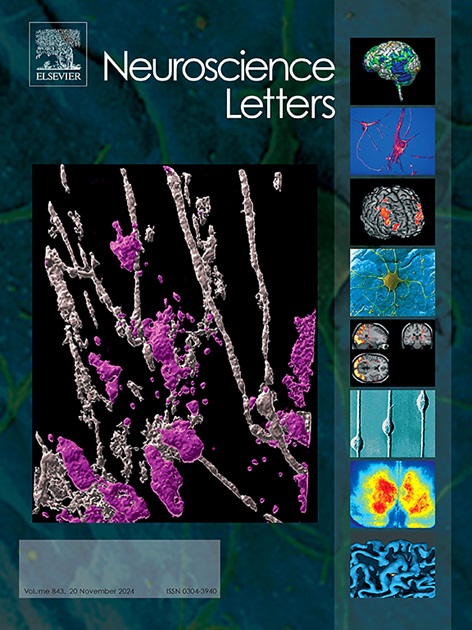In ovo exposure to ethynylestradiol demasculinizes the vasotocin system in the medial preoptic nucleus in male Japanese quail
IF 2.5
4区 医学
Q3 NEUROSCIENCES
引用次数: 0
Abstract
Ethynylestradiol (EE2) is an estrogen that is used predominantly in oral contraceptives and contaminates the environment. In ovo exposure to EE2 impairs copulatory behavior in male Japanese quail, although the mechanisms responsible remain undetermined. The medial preoptic nucleus (POM) plays a pivotal role in male copulatory behaviors and is sexually dimorphic, with a higher number of vasotocin (VT) neuronal fibers in males. In this study, the effects of in ovo EE2 exposure on the VT neuronal fibers of the POM were examined to test the hypothesis that impaired copulatory behaviors caused by EE2 are due to demasculinization of the POM in male birds. Japanese quail embryos were treated with vehicle or EE2 by injecting it into the egg yolk. After the male embryos were hatched and sexually matured, the POM in VT-immunostained and Nissl-stained brain sections, as well as the performance of male sexual behaviors, were analyzed to evaluate the effects of EE2. The analysis of the POM revealed that EE2 treatment significantly decreased the number of VT-immunopositive fibers in the POM of adult male quail, but it did not significantly change the volume of the POM. EE2 dramatically reduced the number and incidence of copulatory behaviors, including neck grabs, mount attempts, mounts, and cloacal contact movements, but it did not affect courtship behaviors, including strutting and crowing. Our results suggest that in ovo EE2 exposure induces demasculinization of the VT system in the POM. The effect of EE2 may be responsible for reducing copulatory behaviors in male Japanese quail.
Significant statement
Embryonic exposure to ethynylestradiol demasculinizes the vasotocin system in the preoptic area, resulting in reduced copulatory behavior in adult male Japanese quail.
卵细胞暴露于乙炔雌二醇使雄性日本鹌鹑视前核内侧的缩宫素系统失雄。
乙炔雌二醇(EE2)是一种雌激素,主要用于口服避孕药,会污染环境。卵暴露于EE2会损害雄性日本鹌鹑的交配行为,尽管其机制尚未确定。内侧视前核(POM)在雄性动物的交配行为中起着关键作用,具有两性二态性,雄性动物的催产素(VT)神经元纤维数量较多。在本研究中,研究了卵中EE2暴露对POM VT神经元纤维的影响,以验证EE2引起的交配行为受损是由于雄性鸟类POM的去雄化造成的。用载体或EE2对日本鹌鹑胚胎进行卵黄注射处理。在雄性胚胎孵化和性成熟后,分析vt免疫染色和nissl染色脑切片的POM以及雄性性行为的表现,以评估EE2的影响。对POM的分析表明,EE2处理显著降低了成年雄性鹌鹑POM中vt免疫阳性纤维的数量,但对POM的体积没有显著影响。EE2显著减少了交配行为的数量和发生率,包括抓脖子、尝试坐骑、坐骑和肛门接触运动,但不影响求爱行为,包括昂首挺胸和啼叫。我们的研究结果表明,在卵细胞中EE2暴露会导致POM中VT系统的去雄化。EE2的作用可能是雄性日本鹌鹑交配行为减少的原因。重要声明:胚胎暴露于乙炔雌二醇会使视前区域的血管催产素系统失雄,导致成年雄性日本鹌鹑的交配行为减少。
本文章由计算机程序翻译,如有差异,请以英文原文为准。
求助全文
约1分钟内获得全文
求助全文
来源期刊

Neuroscience Letters
医学-神经科学
CiteScore
5.20
自引率
0.00%
发文量
408
审稿时长
50 days
期刊介绍:
Neuroscience Letters is devoted to the rapid publication of short, high-quality papers of interest to the broad community of neuroscientists. Only papers which will make a significant addition to the literature in the field will be published. Papers in all areas of neuroscience - molecular, cellular, developmental, systems, behavioral and cognitive, as well as computational - will be considered for publication. Submission of laboratory investigations that shed light on disease mechanisms is encouraged. Special Issues, edited by Guest Editors to cover new and rapidly-moving areas, will include invited mini-reviews. Occasional mini-reviews in especially timely areas will be considered for publication, without invitation, outside of Special Issues; these un-solicited mini-reviews can be submitted without invitation but must be of very high quality. Clinical studies will also be published if they provide new information about organization or actions of the nervous system, or provide new insights into the neurobiology of disease. NSL does not publish case reports.
 求助内容:
求助内容: 应助结果提醒方式:
应助结果提醒方式:


